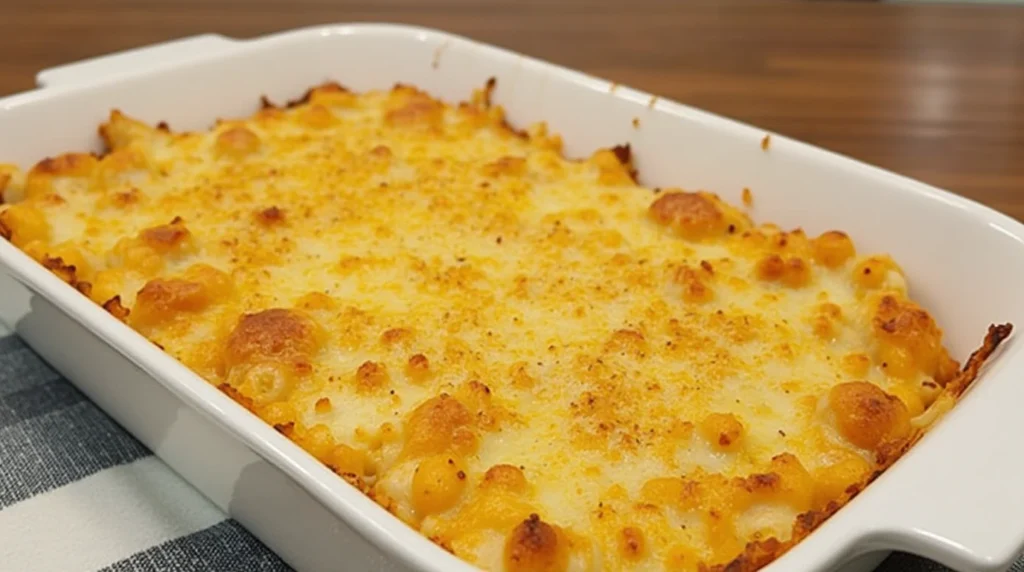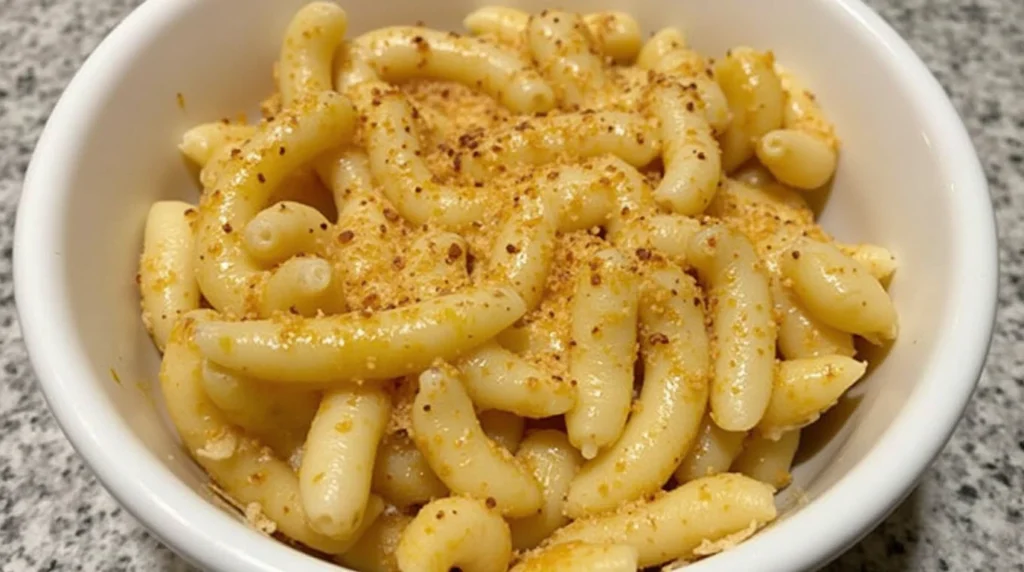Introduction

Baked mac and cheese is the ultimate comfort food, offering a creamy, cheesy, and satisfying meal. Whether it’s a family dinner or a holiday gathering, this dish is always a hit. However, sometimes it doesn’t turn out quite the way you expected. Maybe it’s too dry, too runny, or lacking that irresistible creaminess that makes mac and cheese so beloved. Luckily, fixing baked mac and cheese is easier than you think, and with a few simple tweaks, you can transform any dish into a mac and cheese masterpiece. In this article, we’ll walk you through common problems and show you how to fix baked mac and cheese to ensure it turns out perfectly every time.
Common Problems with Baked Mac and Cheese
Before you can fix baked mac and cheese, it’s important to understand some of the most common issues that might arise during the cooking process.
Dry Mac and Cheese
- Cause: Overcooking the pasta or not adding enough sauce can leave your mac and cheese dry. Pasta absorbs sauce as it bakes, so using too little can result in a parched, crumbly dish.
- Solution: To prevent dryness, ensure you add enough sauce to coat the pasta before baking. Consider mixing in extra butter or cream for added moisture.
Too Saucy or Runny
- Cause: Adding too much milk or undercooking the sauce can cause the mac and cheese to be too runny. This often happens when the cheese sauce doesn’t thicken properly.
- Solution: To fix a runny mac and cheese, cook the sauce longer to allow it to thicken. You can also add a bit more flour to the sauce for extra consistency.
Lack of Creaminess
- Cause: If your mac and cheese lacks the creamy texture you crave, it could be because the wrong cheese was used or the sauce wasn’t prepared properly.
- Solution: Opt for cheeses like cheddar, mozzarella, or gruyère, which melt well and offer a rich, creamy texture. Also, make sure you use enough butter and milk in your sauce.
Lumpy Sauce
- Cause: Lumps in your cheese sauce are often caused by adding cheese to the sauce too quickly or cooking at a high heat.
- Solution: To fix this, lower the heat and whisk the sauce continuously as you add the cheese. If lumps persist, use a hand blender to smooth it out.
How to Make Baked Mac and Cheese Extra Creamy
The key to perfect baked mac and cheese is achieving a luscious, creamy texture. Here are some steps to help you make your dish extra creamy.
Choosing the Right Cheese
- Best Cheeses for Creaminess: Choose cheeses like sharp cheddar, mozzarella, or gruyère for their melting qualities. For a creamier texture, blend in some cream cheese or a little bit of Parmesan.
- The Right Ratio: A good rule of thumb is to use about 2 to 3 cups of cheese per pound of pasta.
Making a Perfect Cheese Sauce
- Béchamel Sauce: Start by making a béchamel sauce (butter, flour, and milk), then gradually whisk in your shredded cheese until it melts smoothly. This will create the creamy base for your mac and cheese.
- Seasoning: Don’t forget to season your sauce with salt, pepper, and a pinch of nutmeg for added flavor.
Adding a Secret Ingredient
- Cream Cheese or Sour Cream: If you want a richer, smoother sauce, try adding a dollop of cream cheese or sour cream. These ingredients will elevate the creaminess without compromising the flavor.
Properly Mixing the Cheese Sauce
- Consistency is Key: Make sure the sauce is fully combined before mixing it with your cooked pasta. You can even use a hand mixer or blender to ensure the sauce is smooth and evenly distributed.
Fixing Too Much or Too Little Cheese in Your Baked Mac
Getting the right balance of cheese in your mac and cheese is essential for flavor and texture.
Adjusting the Cheese Amount
- Too Little Cheese: If your mac and cheese lacks that cheesy richness, simply add more shredded cheese to the sauce or sprinkle extra cheese on top before baking.
- Too Much Cheese: If you’ve overloaded your mac and cheese with cheese, it may become greasy. To fix this, you can add a bit more milk or butter to balance it out.
The Importance of Cheese Variety
- Boost Flavor: Sharp cheddar brings out a bold flavor, while mozzarella adds creaminess. If your mac and cheese feels bland, add more varieties like Parmesan, Gruyère, or even a touch of blue cheese for a unique twist.
Ensuring a Crunchy Topping
- Breadcrumbs and Cheese Balance: Ensure that you have enough cheese for the creamy sauce, but also enough to sprinkle a crunchy topping. A mix of breadcrumbs and a little extra cheese will give your baked mac and cheese a perfect crunch.
How to Avoid Overloading with Cheese
- Proportions Matter: Stick to the cheese-to-pasta ratio to avoid making your dish too greasy. Overloaded cheese can also prevent the sauce from fully binding with the pasta, leaving you with a less-than-ideal dish.

How to Achieve a Perfectly Crispy Topping on Baked Mac and Cheese
The topping is the final touch that makes baked mac and cheese irresistible.
Breadcrumbs for Crunch
- Best Breadcrumbs for Mac: Use panko breadcrumbs for extra crunch, or opt for seasoned breadcrumbs to add flavor. The breadcrumbs should be lightly toasted in butter before sprinkling over the mac and cheese.
Butter and Seasoning for the Top
- Enhancing Flavor: A drizzle of melted butter over the breadcrumbs helps achieve a golden, crispy crust. Add herbs like parsley or thyme for extra flavor.
Grilling the Top for Extra Crispiness
- Broil for Perfection: If you want an extra crispy topping, place the mac and cheese under the broiler for a minute or two at the end of baking. Keep a close eye on it to avoid burning.
Alternative Toppings
- Get Creative: You can try other topping options like crushed crackers, crispy bacon bits, or even a sprinkle of Parmesan cheese for added texture and flavor.
Essential Tips for Perfecting Your Baked Mac and Cheese Every Time
To ensure your baked mac and cheese turns out perfectly every time, follow these essential tips.
Don’t Overcook the Pasta
- Al Dente: Cook your pasta al dente, as it will continue to cook while baking. Overcooked pasta can become mushy and lose its texture.
Use a Proper Baking Dish
- Right Size: Use a baking dish that fits the amount of mac and cheese you’re making. Too large a dish will dry out the mac and cheese, while too small a dish may not cook evenly.
How Long to Bake
- Baking Time: Bake at 350°F for 20-25 minutes, or until the top is golden and crispy. You can check for doneness by poking a fork into the middle of the dish to ensure it’s hot throughout.
Resting Time
- Let It Set: Allow the mac and cheese to rest for 5-10 minutes after baking. This helps it set and makes it easier to serve.
Table: Ingredients for Baked Mac and Cheese Recipe
| Ingredient | Amount |
|---|---|
| Elbow macaroni | 1 lb (16 oz) |
| Butter | 4 tbsp |
| Flour | 4 tbsp |
| Milk (whole) | 2 cups |
| Heavy cream | 1 cup |
| Sharp cheddar cheese | 2 cups |
| Mozzarella cheese | 1 cup |
| Gruyère cheese | 1 cup |
| Salt | 1 tsp |
| Pepper | 1/2 tsp |
| Panko breadcrumbs | 1 cup |
| Butter (for topping) | 2 tbsp |
How to Make Baked Mac and Cheese Extra Creamy
Choosing the Right Cheese
- Cheese Variety: The right combination of cheeses can transform the texture and richness of your baked mac and cheese. Try mixing sharp cheddar for bold flavor, mozzarella for a gooey stretch, and Gruyère for a nutty depth. Other options include Fontina or Monterey Jack.
- Best Cheese Pairings for Creaminess: If you want to get super creamy, opt for cheeses with higher fat content. Full-fat cream cheese or a combination of mascarpone and cream cheese can take your dish to the next level.
Making a Perfect Cheese Sauce
- Start with a Roux: A béchamel (milk + butter + flour) base is key for smoothness. Use a whisk to slowly incorporate the milk into the butter-flour mixture over medium heat until it thickens. This process ensures a silky texture.
- Gradually Add Cheese: After the roux has thickened, reduce the heat to low before adding your shredded cheese. This will prevent the cheese from separating or becoming grainy.
- Cook Low and Slow: Allow the sauce to simmer for a few minutes. Avoid high heat, which can cause the sauce to break.
Adding a Secret Ingredient
- Sour Cream or Cream Cheese: Adding a spoonful of sour cream or a few ounces of cream cheese helps to boost both the texture and flavor. Sour cream adds tang, while cream cheese adds smoothness.
- Milk Alternatives: For a more indulgent twist, try substituting some of the milk with heavy cream or even half-and-half to increase the richness of your sauce.
Properly Mixing the Cheese Sauce
- Toss the Pasta Well: After creating your cheese sauce, mix it into your pasta thoroughly. Be sure every piece of pasta is coated evenly to avoid dry spots and ensure a creamy bite every time.
- Use a Large Bowl: When combining, use a big mixing bowl to help distribute the cheese sauce evenly.

Fixing Too Much or Too Little Cheese in Your Baked Mac
Adjusting the Cheese Amount
- For Cheese-Starved Mac: If you find your mac too dry or lacking in cheese flavor, simply add more shredded cheese. Don’t forget to add a bit more milk or cream to help distribute the cheese evenly through the pasta.
- How to Fix Overly Cheesy Mac: If the mac and cheese feels too heavy or greasy, reduce the amount of cheese in your sauce by balancing it out with extra milk or using a blend of lighter cheeses, such as mozzarella.
The Importance of Cheese Variety
- For Bold Flavor: If your mac and cheese is too bland, consider adding sharp cheddar, Parmesan, or Gruyère. These cheeses provide a fuller flavor and complement each other well when used together.
- For Flavor Balance: Mix different textures and fat contents. For example, mixing a creamy cheese (like mozzarella) with a sharp cheese (like aged cheddar) can help create complexity and avoid a one-dimensional flavor profile.
Ensuring a Crunchy Topping
- Breadcrumbs for Texture: Ensure there’s enough cheese left to sprinkle a thick layer over the breadcrumbs for a golden, crispy topping. Mix breadcrumbs with melted butter and a bit of grated Parmesan for an irresistible finish.
- Cheese-to-Pasta Ratio: For an extra cheesy mac and cheese, use around 2 cups of shredded cheese per pound of pasta. Keep the sauce ratio in check to avoid an overly greasy dish.
How to Avoid Overloading with Cheese
- Right Balance: While cheese is essential, avoid overloading your mac and cheese with too much cheese. If the sauce becomes too thick or greasy, simply add some extra milk or broth to loosen it up.
How to Achieve a Perfectly Crispy Topping on Baked Mac and Cheese
Breadcrumbs for Crunch
- Use Panko: Panko breadcrumbs work best for a crisp, light texture that holds up well during baking. They don’t absorb too much moisture, ensuring your topping stays crunchy.
- Season the Breadcrumbs: Don’t forget to season your breadcrumbs! Add garlic powder, paprika, or dried herbs like thyme or parsley for extra flavor.
Butter and Seasoning for the Top
- Butter Makes It Golden: Butter helps the breadcrumbs toast and achieve that golden, crispy finish. Drizzle melted butter on top before baking to ensure a beautifully browned crust.
- Flavor Enhancements: Adding herbs like rosemary or thyme to the butter mix can make the crust even more flavorful. For extra richness, you can even sprinkle some grated cheese over the top of the breadcrumbs.
Grilling the Top for Extra Crispiness
- Use the Broiler: For an even crispier finish, turn on the broiler during the last few minutes of baking. Watch closely to avoid burning but enjoy that perfect crispy top.
- Timing is Key: After the mac and cheese has baked, place it under the broiler for 2-3 minutes until the top is golden and bubbly.
Alternative Toppings
- Crushed Crackers or Chips: For a different crunch, crush up some crackers or chips like Ritz crackers or potato chips. These provide a slightly salty, crunchy topping that pairs perfectly with the creamy mac.
- Bacon Bits: Crumbled crispy bacon bits also add a savory crunch and complement the richness of the mac and cheese.

Conclusion
Fixing baked mac and cheese doesn’t have to be a challenge. With the right cheese, a perfectly smooth sauce, and a crispy topping, you can transform any mac and cheese disaster into a delicious dish. Remember, it’s all about balance—whether it’s the cheese, sauce, or toppings. Now that you know how to fix common problems, it’s time to experiment with different ingredients and techniques to create your ideal mac and cheese.
Call to Action: Have your own tips for perfect baked mac and cheese? Share your thoughts and favorite recipes in the comments below!
FAQ: How Do You Fix Baked Mac and Cheese?
1. How do I fix dry baked mac and cheese?
- Dry mac and cheese can be fixed by adding extra sauce, butter, or cream. Make sure to coat the pasta thoroughly before baking, and don’t skimp on the sauce.
2. Why is my baked mac and cheese too runny?
- If your mac and cheese is too runny, it might be because the sauce wasn’t cooked long enough. Simmer it until it thickens properly before mixing it with the pasta.
3. What cheese should I use for creamy baked mac and cheese?
- Cheeses like sharp cheddar, mozzarella, and gruyère are great for a creamy texture. Blending different cheeses adds depth and richness to the flavor.
4. How do I make a crunchy topping for my mac and cheese?
- To get a crunchy topping, use panko breadcrumbs and toast them with melted butter before sprinkling on top. You can broil for a minute for extra crispiness.
5. Can I fix mac and cheese if it’s too cheesy?
- Yes! If your mac and cheese is too cheesy or greasy, add more milk or butter to balance the flavors and make the sauce smoother.
